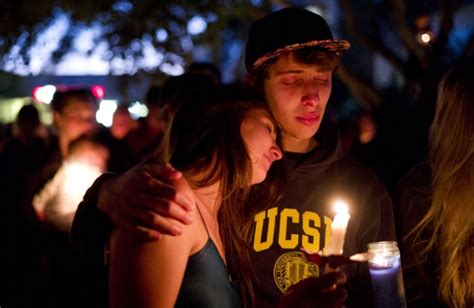The UCSB shooting, also known as the Isla Vista shooting, was a tragic incident that occurred on May 23, 2014, in Isla Vista, California, near the University of California, Santa Barbara (UCSB). The shooting resulted in the deaths of six people and injured fourteen others. The incident was carried out by Elliot Rodger, a 22-year-old student at Santa Barbara City College, who had a history of mental health issues and had become increasingly isolated and resentful towards society.
Background of the Shooter
Elliot Rodger was born on July 24, 1991, in London, England, to a British father and a Malaysian-Chinese mother. His family moved to the United States when he was young, and he grew up in a relatively affluent environment in California. Despite his privileged background, Rodger struggled with social interactions and had difficulty making friends. He was diagnosed with high-functioning autism and suffered from a range of mental health issues, including anxiety and depression.
Rodger’s family had been concerned about his behavior and had sought help from mental health professionals. However, they had also been hesitant to involve law enforcement or take more drastic measures, hoping that with the right treatment, Elliot would be able to manage his issues and lead a normal life. It is now known that in April 2014, just a month before the shooting, Elliot’s parents had become aware of a series of disturbing videos he had posted online, in which he talked about his desire for revenge against the world for what he perceived as injustices against him. They contacted his therapist, who in turn contacted the police, but a welfare check conducted by the Santa Barbara County Sheriff’s Office found Elliot to be polite and courteous, and no further action was taken at the time.
The Shooting Incident
On the evening of May 23, 2014, Elliot Rodger set out to carry out his plan of revenge. He began by killing his two roommates and a visitor in his apartment, stabbing each of them multiple times. He then drove to the Alpha Phi sorority house near the UCSB campus, where he attempted to gain entry but was unable to do so. Frustrated, he opened fire on a group of students outside the house, killing two women, Katherine Cooper and Veronika Weiss. He continued his rampage, driving to a nearby deli, where he shot and killed a student, Christopher Michaels-Martinez. Over the next ten minutes, Rodger drove through Isla Vista, shooting at pedestrians and other drivers, injuring several people.
Rodger’s interactions with law enforcement during the shooting were significant. At one point, he exchanged gunfire with police officers, and he was eventually found dead in his vehicle with a self-inflicted gunshot wound. The entire incident, from the first 911 call to Rodger’s death, lasted approximately 20 minutes.
Aftermath
The UCSB shooting was widely condemned, and it sparked a national conversation about gun violence, mental health, and misogyny. The incident was seen as a particularly heinous example of a growing trend of mass shootings in the United States, and it led to renewed calls for stricter gun control laws and better resources for mental health treatment.
In the aftermath of the shooting, the University of California, Santa Barbara, and the surrounding community came together to mourn the victims and support the survivors. Memorials were held for the victims, and a fund was established to support the families of those affected by the tragedy.
Elliot Rodger’s manifesto, a 141-page document that he had written and posted online before the shooting, was widely discussed in the media. The document outlined his frustrations with women, who he felt had rejected him, and his anger towards the world for what he perceived as its injustices against him. It also detailed his planning for the attack and his expectation that it would lead to his death.
Impact on Gun Control and Mental Health Discussions
The UCSB shooting had a significant impact on discussions around gun control and mental health in the United States. It highlighted the need for better ways to identify and treat individuals with mental health issues before they escalate into violent behavior. Additionally, it raised questions about the accessibility of firearms, especially for those with a history of mental health issues or violent behavior.
In response to the shooting, California passed several laws aimed at reducing gun violence, including a law that allows family members or law enforcement to petition for a temporary removal of firearms from individuals who pose a risk to themselves or others. This type of law, known as a “red flag” law, has since been adopted by several other states.
Victim Profiles
- Katherine Cooper, 22, was a senior at UCSB. She was known for her outgoing personality and her love of adventure.
- Veronika Weiss, 19, was a freshman at UCSB. She was remembered for her kindness and her passion for photography.
- Christopher Michaels-Martinez, 20, was a sophomore at UCSB. He was known for his love of sports and his dedication to his studies.
- Cheng Yuan Hong, 20, James Cheng Hong’s cousin, and Weihan Wang, 20, were Rodger’s roommates. They were both students at the time of their deaths.
- George Chen, 19, was a visitor to Rodger’s apartment. He was a high school friend of Hong’s and had stopped by for a visit.
Each of the victims had a unique story, filled with promise and potential that was tragically cut short by the actions of Elliot Rodger.
Remembering the Victims and Honoring Their Memories
The UCSB community and beyond continue to remember the victims of the Isla Vista shooting, honoring their memories with various tributes and memorials. The university has established scholarships and programs in the names of the victims, aiming to keep their spirits alive through support for future generations of students. Annual memorial services and moments of silence are observed to reflect on the lives lost and the impact of the tragedy on the community.
Efforts to learn from the incident and to prevent similar tragedies in the future are ongoing, including initiatives in mental health support, gun safety, and community engagement. The legacy of the victims lives on through these efforts, serving as a reminder of the importance of compassion, understanding, and collective action against violence.
What were the immediate causes of the UCSB shooting?
+The immediate causes of the UCSB shooting were rooted in the mental health issues and personal grievances of the perpetrator, Elliot Rodger. His manifesto detailed feelings of isolation, rejection, and a deep-seated misogyny, which ultimately led to his violent actions.
How did the community respond to the shooting?
+The community responded with shock, sadness, and a deep sense of loss. Memorials were held, and support funds were established for the families of the victims. The incident also spurred discussions and actions regarding gun control, mental health support, and community engagement to prevent future tragedies.
What legislative changes resulted from the UCSB shooting?
+The UCSB shooting led to the passage of “red flag” laws in California and other states, which allow law enforcement or family members to petition for the temporary removal of firearms from individuals deemed to be a risk to themselves or others. This was part of a broader effort to address gun violence and mental health issues.



